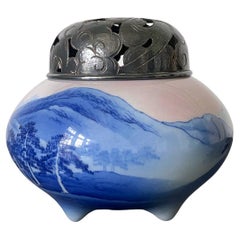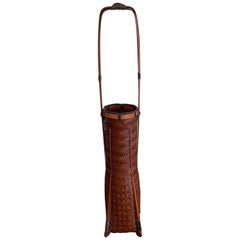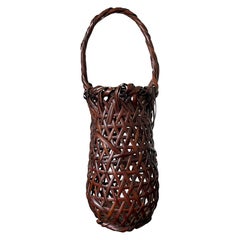Japanese Scholar's Objects
85
to
9
52
7
85
85
85
3
1
14
31
40
18
8
4
3
2
1
1
1
30
23
20
14
12
388
359
255
85
33
2
2
2
2
1
Place of Origin: Japanese
Japanese Old Tea Ceremony Pot Chagama "Trellice and Flowers" Immediately Usable
Located in South Burlington, VT
From our recent Japanese acquisitions with original signed box.
A finely cast Japanese traditional iron teapot -chagama- with a wonderful relief band and design of summer time bam...
Category
Mid-20th Century Showa Japanese Scholar's Objects
Materials
Iron, Bronze
Japanese Glazed Ceramic and Silver Koro Incense Burner Makuzu Kozan
By Makuzu Kozan
Located in Atlanta, GA
A tri-pod ceramic incense burner (koro) by Japanese Imperial potter Makuzu Kozan (1842-1916) circa late Meiji to the start of Taisho period (1890-1910s). A fine example of the artist's work belonging to the late part of his underglaze paint phase (started around 1887 until his death), the surface of the koro was painted in beautiful shades of blue to depict a continuous landscape not unlike a traditional ink and watercolor hand scroll. The rise and fall mountains recede and fade into the horizon and are dotted with groves of pines. The sky is painted with a beautiful subtle shade of pink, suggesting a time of sunrise or sunset. The koro is fitted with an ensuite reticulated sterling silver hoya (incense cover), pierced with swirling cloud and marked with "pure silver' in Kanji. The base is signed in underglaze blue "Makuzu Kozan Sei" within a double ring. The piece is beautifully potted in form and the decoration was done with expertise using the novel technique developed by Kozan called Fuki-e (the blow painting), in order to achieve the striking landscape known as "Mountain and Water" with sense of dimensions and gradient, the poetic effects normally conveyed only by sumi ink staining on paper. The piece comes with an unsigned tomobako (wood storage box) of a recent age.
Also known as Miyagawa Kozan (1842–1916), Makuzu Kozan was one of the most established and collected ceramist from Meiji Period. Born as Miyagawa Toranosuke, Kozan established his pottery studio in Yokohama around 1870s and later became one of the appointed artists to the Japanese Imperial household. His work was exhibited in many international fairs that the Meiji government participated at the turn of the century and won many grand prizes. Being one of the most creative ceramists, Kozan started experimenting with new chemical colors from the West in the format of his porcelain glaze around 1880s. New colors allowed him to create underglaze designs that appeared bright, smooth and glossy. He even invented his own receipt of cobalt blue to achieve a much brighter yet softer shade, as evident on this vase. To create landscape that is realistic and dimensional, more common in the western paintings, he was inspired by the native Japanese ink painting technique developed around 1900 by Yokoyama...
Category
Early 1900s Japonisme Antique Japanese Scholar's Objects
Materials
Silver
Elegant Japanese Lacquered Ikebana Bamboo Basket
Located in Atlanta, GA
A vintage Japanese ikebana made from lacquered bamboo basketry circa first half of the 20th century. This piece of bamboo art displays an very light and delicate classic tapered squa...
Category
Early 20th Century Japonisme Japanese Scholar's Objects
Materials
Bamboo, Rattan
Unique Japanese Woven Bamboo Hanging Ikebana Basket Suzuki Gengensai
By Suzuki Gengensai
Located in Atlanta, GA
A rare hanging ikebana basket by Japanese bamboo artist Suzuki Gengensai (1891-1950) circa 1923-50. This elegant hanakago was made entirly from white bamboo. It consists of a square ...
Category
Mid-20th Century Modern Japanese Scholar's Objects
Materials
Bamboo, Rattan
Japanese Bamboo Basket Ikebana Suzuki Gengensai
By Suzuki Gengensai
Located in Atlanta, GA
An elegantly woven bamboo basket with handle as an ikenana container by Suzuki Gengensai (1891-1950) circa 1923-50. Suzuki Gengensai was from Kansai region and active in Osaka. He studied bamboo art under Yamashita Kochikusai (1876-1947) and became an independent artist in 1913. He received his artist name Gengensai in 1914 and in 1923 he changed the characters to Gen, a slight written variation of the character. This basket was signed in this later variation, which helps to date the piece to post 1923.
The basket is woven entirely in a free style irregular plating on the body and with a twisted bundled handle. The surface is lacquered in a deep reddish color. The seemingly less rigid technique renders the piece a more rustic and natural aesthetic that is more suitable for certain occasions. It is singed on the base with artist's signature in the variation post 1923.
A very similar basket of the irregular weaving but without the handle is illustrated in plate 72 in "Baskets Masterpieces of Japanese Bamboo Art...
Category
20th Century Japonisme Japanese Scholar's Objects
Materials
Bamboo
Japanese Connoisseurs Collection Fine Antique Smoking Pipes Kiseru
Located in South Burlington, VT
Rare one-of-a-kind collection
Japanese Connoisseurs Collection of Five (5) Fine Antique Smoking Pipes, Kiseru.
You dont need to be a conn...
Category
19th Century Meiji Antique Japanese Scholar's Objects
Materials
Bronze, Copper, Sterling Silver, Gold
Japanese Contemporary Bamboo Basket by Abe Motoshi
By Abe Motoshi
Located in Atlanta, GA
A Japanese Ikebana basket woven by bamboo artist Abe Motoshi (Japanese, b. 1942). Constructed with Madake bamboo and rattan with technique of o...
Category
Late 20th Century Modern Japanese Scholar's Objects
Materials
Bamboo, Rattan
Japanese Meiji Period Mixed Metal Pair of Scroll Weights Depicting Samurai
Located in Gainesville, FL
Japanese Meiji period fine pair of scroll weights decorated with shakudo and silver samurai figures. The weights fill solid and heavy. One of the weights has Japanese writing ( see i...
Category
19th Century Meiji Antique Japanese Scholar's Objects
Materials
Metal
Japanese Bamboo Basket Ikebana by Tanabe Chikuunsai II
By Tanabe Chikuunsai II 1
Located in Atlanta, GA
A woven bamboo flower Ikebana basket by Tanabe Chikuunsai II (1921-2000) from Showa era (1926-1989), circa 1950-1960s. The ikebana basket takes a vertical square form, the body was e...
Category
20th Century Japonisme Japanese Scholar's Objects
Materials
Bamboo, Wood
Unique Japanese Lacquer Maki-e Suzuribako with Woven Bamboo Cover with Tomobako
Located in Atlanta, GA
This Japanese suzuribako (ink box) of late Meiji Period (circa end of 19th century) is uncommon with its surface covered with woven basketry in che...
Category
Late 19th Century Japonisme Antique Japanese Scholar's Objects
Materials
Rattan, Wood, Lacquer
Two Japanese Bronze Shells
Located in New York, NY
These charming bronze shells were cast in Japan in the 19th century. They lived for many years in the collection of the Paris artist Pierre Le-Tan. One of...
Category
19th Century Edo Antique Japanese Scholar's Objects
Materials
Bronze
Japanese Lacquer Tray with Maki-e and Inlay Hara Yoyusai Edo Period
Located in Atlanta, GA
A lovely Japanese lacquer rectangular lacquer tray with a slightly scalloped corner and four L shape supporting feet by one of the most celebrated lacquer artist active in Edo period Hara Yoyusai (1772-1845). Yoyusai lived in Edo (Tokyo) and worked under the patronage of Lord Matsudaira. He operated a large workshop and had a very prolific output of lacquer objects. Most survived pieces being inro...
Category
19th Century Japonisme Antique Japanese Scholar's Objects
Materials
Wood, Lacquer
Japanese Satsuma Ceramic Ewer Yabu Meizan
By Yabu Meizan
Located in Atlanta, GA
A Satsuma ware miniature ewer from the studio of Yabu Meizan (birth name Yabu Masashichi; 1853-1934), who was one of the most celebrated and collectible Satsuma artists from the Meij...
Category
Early 20th Century Japonisme Japanese Scholar's Objects
Materials
Ceramic
Finely Carved Japanese Okimono on Stand
Located in Atlanta, GA
An antique Okimono (Japanese means artsy display ornament object) displayed on a small custom wood stand from Meiji Period circa early 2oth century. T...
Category
Early 20th Century Japonisme Japanese Scholar's Objects
Materials
Wood
Japanese Rare Antique Inlaid Smoking Tansu, Complete 1850
Located in South Burlington, VT
The first we have seen
A spectacular and hard to find Inlaid mother of pearly - using the raden technique- and lacquered three-drawer Tansu complete with all original bronze accoutrement including a fine engraved antique long pipe and two removable covered bronze cylinders all executed by expert mid-19th century Edo samurai...
Category
19th Century Edo Antique Japanese Scholar's Objects
Materials
Bronze
Meiji Period Shagreen Clad Cane with Minamoto Clan Crest
Located in Kilmarnock, VA
Rare late 19th century Meiji period cane clad in spiraled shagreen with the Minamoto Clan Crest in sterling, which at one point was the imperial family and a shogun of Japan. Cap is ...
Category
1880s Meiji Antique Japanese Scholar's Objects
Materials
Sterling Silver, Wrought Iron
Rare Japanese Traveling Cabinet Oi Edo Period
Located in Atlanta, GA
Served as a traveling cabinet as well as a shrine and carried like a backpack for the Buddhist priests and monks during long pilgrimage, this rare chest is known as Oi Japanese. In China the carrier case is known as Ji, traditionally used by the traveling scholars or monks in the ancient time to carry their belongings such as books, clothes, and stationary. The piece on offer here is of Japanese origin and dated to Edo period (circa 17-18th century), possibly older to 16th century of Momoyama or Muromachi period. It was likely reserved for the use of a high-rank priest to carry the Buddhism scripts based on its luxurious high quality. The wood frame takes the shape of a pagoda with carved bamboo design that features upturned corner cornices...
Category
18th Century Edo Antique Japanese Scholar's Objects
Materials
Silk, Bamboo, Wood, Lacquer, Paper
Japanese Meiji Lacquer Writing Set
Located in New Orleans, LA
This remarkable Japanese portable writing set contains the instruments of sublime artistic expression. Also known as a yatate, this Meiji-period set i...
Category
19th Century Meiji Antique Japanese Scholar's Objects
Materials
Stone
Elegant Japanese Edo Period Rack
Located in New York, NY
This refined object dates to the first half of the 19th century, and was probably used for obi, kimono sashes, which were hung over it. The gold decorations on the black-lacquered g...
Category
1830s Edo Antique Japanese Scholar's Objects
Materials
Lacquer
Antique Brass Engraved Persian, Japanese & Egyptian Pen Case Ink Well Group Lot
Located in Hamilton, Ontario
Dating from the early 18th century, this grouping of brass pen cases have their origins in Persia, Egypt and Japan respectively. Each case is intricately engraved with a patterned sc...
Category
18th Century Anglo-Indian Antique Japanese Scholar's Objects
Materials
Brass
Awaji Shima Pottery Brush Pot Artist's Vase Arts & Crafts Bronze Weaving
By Awaji Pottery
Located in Wilton, CT
Great Awaji brush pot with bronze weaving, circa 1910. Impressed double diamond mark from the Sumoto (Capital of the island) Kiln. Measures: 5 1/2" high, ...
Category
1910s Arts and Crafts Vintage Japanese Scholar's Objects
Materials
Pottery
Japanese Kyoto Ware Vase Attributed to Ninsei
Located in Atlanta, GA
An elegant vase made in Kyoto, Japan, circa 1920s. With a graceful elongated Mei-Ping form, it was likely used as a flower holder during the tea ceremony. The stoneware body has an incised and raised design of Irises in an over glazed indigo blue, an subject matter and composition found in the contemporary paintings and screens, cherished by the literati of the Kyoto society.
The vase has a white glazed background sprinkled with dust for a rustic effect. The blue glaze displays some burst of bubbles upon close inspection, suggesting its age. Under the base, there is a small impressed mark of Ninsei (born Nonomura Seisuke) a famous potter from the 17th century, who was considered the founder the Kyoto ware...
Category
1920s Japonisme Vintage Japanese Scholar's Objects
Materials
Ceramic
Antique Japanese Awaji Pottery Tanuki Figure Kintsugi Scholar's Desk Object
By Awaji Pottery
Located in Wilton, CT
Antique Awaji pottery water dropper in the form of a Tanuki hovering over his large belly, sake flask, scrotum? 19th century. 2 15" high, 3" long, 1 3/4" deep. Two tiny kintsugi gilt...
Category
Late 19th Century Meiji Antique Japanese Scholar's Objects
Materials
Pottery
Japanese Pair Antique Hand Carved Prosperity and Business Lucky Gods
Located in South Burlington, VT
Japan, a wonderful pair (2) finely hand carved hardwood sculptures of Ebisu and Daikoko, two of Japan's seven lucky gods signifying prosperity, good busines...
Category
Early 20th Century Showa Japanese Scholar's Objects
Materials
Wood
Japanese Edo Period Lacquer and Mother-of-Pearl Embellished Stoneware Koro
Located in Austin, TX
A highly unusual Japanese crackle glazed koro (incense burner or censer), lacquered and inlaid with mother-of-pearl embellishment, signed Gyokusen, Ed...
Category
19th Century Edo Antique Japanese Scholar's Objects
Materials
Copper
Furo Tea Ceremony Hibachi by Raku Kichizaemon xi Keinyu, 1817-1902
By Raku Kichizaemon XI Keinyu
Located in Prahran, Victoria
A furo tearoom brazier by Raku Kichizaemon XI Keinyu (1817-1902) decorated in bold style over a brick red glaze. The classical scene depicts men in ‘mino’ straw raincoats pulling a barge up river under the overhanging branches of an ancient willow tree.
With makers mark to base and sold with its original paulownia wood storage box.
Overall the piece is in excellent condition but has sustained several stress cracks in one corner due to heat encountered during continual use. This is typical of Japanese raku ceramics...
Category
Late 19th Century Meiji Antique Japanese Scholar's Objects
Materials
Pottery
Japanese Stone Object with a hole
Located in Sammu-shi, Chiba
This is an old Japanese stone object.
It is shaped like a naturally formed lantern.
The unique expression created by moss and rainwater over many years is very beautiful, and it is a...
Category
15th Century and Earlier Japonisme Antique Japanese Scholar's Objects
Materials
Stone
Recently Viewed
View AllMore Ways To Browse
Antique Chinese Calligraphy Set
Japanese Scholars Box
Archer Ring
Antique Chinese Inkstone
Gongshi Stones
Lingbi Stone
Lingbi Scholar Stones
Taihu Rock
Carved Bone Horses
Brush Washer
Chinese Brush Holder
Qing Ink Stone
Antique Calligraphy Tools
Calligraphy Brush Stand
Chinese Brush Washer
Japanese Suiseki
Chinese Calligraphy Brush And Stand
Chinese Calligraphy Brush Stand





